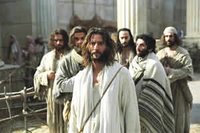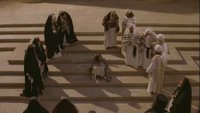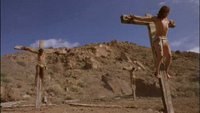
My wife and I have been working through Philip Saville's
Gospel of John (2003). It's one of those films that there is obviously no point doing a scene analysis for because it's a word for word reproduction of the fourth gospel. However, there is plenty of other things to say about the film. Firstly, in watching it again, I'm surprised that this film avoided criticism for being anti-Semitic given that it was released during the period when Mel Gibson's film was being pre-emptively protested against. It's true that this film did employ the wise tactic of utilising an advisory panel of scholars, and that the film-makers implemented one of their suggestions to open the film with some text explaining the context in which the gospel was written.

Nevertheless, when I try to explain the problems with Gibson's film, the kinds of problems that I tend to point to all seem to be present here. Lack of neutral Jewish characters (tick). A noble sensitive Pilate in contrast to a swarthy, shifty looking bunch of Jewish elders (tick). There are various other points of similarity, but most of these relate to the text, and here the comparison falters.
The Gospel of John is, by nature of the project, stuck with some of its textual difficulties, and these are mitigated to some degree by the disclaimer. Gibson, on the other hand, had free reign, and so chose to favour John's weak-willed Pilate, instead of the butcher we read about in
Luke 13:1-3 (and various non-biblical sources). Of course, you could ask why the film-makers chose this particular gospel instead of Mark or Luke (having already completed
Matthew in 1994), but then I suppose the similarities between the synoptic gospels would make John the most appealing.

Once again I was impressed with Henry Ian Cusick's portrayal of Jesus. Cusick notes in one of the DVD extras that there are certain Johannine passages which he couldn't do anything but recite with a degree of anger. Given that there are a several such confrontational passages, it's surprising that Cusick's Jesus still manages to come across as warm and approachable. Equally impressive is Christopher Plummer's narration, and Stuart Bunce's silent role as "John",(who should really have been credited as "the disciple whom Jesus loved"). It's interesting (and perhaps a little disappointing) that it's Plummer, not Cusick who gets to deliver the immortal words of John 3:16. Given that the gospel puts them on Jesus's lips, I'd be interested to see the proportion of films using this verse that actually have Jesus saying it.

I was also impressed with some of the historical details that this film gets right, and in a few cases it chooses to go against the majority of Jesus films. Most notably, Jesus is nailed to the cross through his ankles on either side of the upright. I've always intrigued by the way numerous portrayals show the crucifixion of the two theives in a variety of ways, but Jesus is usually crucified in accordance with standard iconography. A break was made with this pattern for the Jesus films of the late eighties (
Last Temptation of Christ and
Jesus of Montreal), but things soon settled down again. Another such break is made with the mode of Jesus carrying the cross piece. Until
Jesus of Nazareth in 1977 films tended to portray the whole cross being dragged up to Golgotha. Since then, most films (although not Gibson's) have shown Jesus just carrying the crosspiece upon his shoulders. Here though, the crosspiece is simply slung over just one shoulder. I have no idea that there is anymore historical precedent for this, but I suppose at least it draws the viewer's attention to the uncertainty we have over this part of the practice.

Finally, the shot on the right, really stood out this time around as reminiscent of the
closing shot from Ingmar Bergman's
The Seventh Seal. In fact, the only time the shot is not overlaid in
John, is when it is shown in a black and white flashback. I wonder if this is an intentional reference or just coincidence.
 My wife and I have been working through Philip Saville's Gospel of John (2003). It's one of those films that there is obviously no point doing a scene analysis for because it's a word for word reproduction of the fourth gospel. However, there is plenty of other things to say about the film. Firstly, in watching it again, I'm surprised that this film avoided criticism for being anti-Semitic given that it was released during the period when Mel Gibson's film was being pre-emptively protested against. It's true that this film did employ the wise tactic of utilising an advisory panel of scholars, and that the film-makers implemented one of their suggestions to open the film with some text explaining the context in which the gospel was written.
My wife and I have been working through Philip Saville's Gospel of John (2003). It's one of those films that there is obviously no point doing a scene analysis for because it's a word for word reproduction of the fourth gospel. However, there is plenty of other things to say about the film. Firstly, in watching it again, I'm surprised that this film avoided criticism for being anti-Semitic given that it was released during the period when Mel Gibson's film was being pre-emptively protested against. It's true that this film did employ the wise tactic of utilising an advisory panel of scholars, and that the film-makers implemented one of their suggestions to open the film with some text explaining the context in which the gospel was written.  Nevertheless, when I try to explain the problems with Gibson's film, the kinds of problems that I tend to point to all seem to be present here. Lack of neutral Jewish characters (tick). A noble sensitive Pilate in contrast to a swarthy, shifty looking bunch of Jewish elders (tick). There are various other points of similarity, but most of these relate to the text, and here the comparison falters. The Gospel of John is, by nature of the project, stuck with some of its textual difficulties, and these are mitigated to some degree by the disclaimer. Gibson, on the other hand, had free reign, and so chose to favour John's weak-willed Pilate, instead of the butcher we read about in Luke 13:1-3 (and various non-biblical sources). Of course, you could ask why the film-makers chose this particular gospel instead of Mark or Luke (having already completed Matthew in 1994), but then I suppose the similarities between the synoptic gospels would make John the most appealing.
Nevertheless, when I try to explain the problems with Gibson's film, the kinds of problems that I tend to point to all seem to be present here. Lack of neutral Jewish characters (tick). A noble sensitive Pilate in contrast to a swarthy, shifty looking bunch of Jewish elders (tick). There are various other points of similarity, but most of these relate to the text, and here the comparison falters. The Gospel of John is, by nature of the project, stuck with some of its textual difficulties, and these are mitigated to some degree by the disclaimer. Gibson, on the other hand, had free reign, and so chose to favour John's weak-willed Pilate, instead of the butcher we read about in Luke 13:1-3 (and various non-biblical sources). Of course, you could ask why the film-makers chose this particular gospel instead of Mark or Luke (having already completed Matthew in 1994), but then I suppose the similarities between the synoptic gospels would make John the most appealing. Once again I was impressed with Henry Ian Cusick's portrayal of Jesus. Cusick notes in one of the DVD extras that there are certain Johannine passages which he couldn't do anything but recite with a degree of anger. Given that there are a several such confrontational passages, it's surprising that Cusick's Jesus still manages to come across as warm and approachable. Equally impressive is Christopher Plummer's narration, and Stuart Bunce's silent role as "John",(who should really have been credited as "the disciple whom Jesus loved"). It's interesting (and perhaps a little disappointing) that it's Plummer, not Cusick who gets to deliver the immortal words of John 3:16. Given that the gospel puts them on Jesus's lips, I'd be interested to see the proportion of films using this verse that actually have Jesus saying it.
Once again I was impressed with Henry Ian Cusick's portrayal of Jesus. Cusick notes in one of the DVD extras that there are certain Johannine passages which he couldn't do anything but recite with a degree of anger. Given that there are a several such confrontational passages, it's surprising that Cusick's Jesus still manages to come across as warm and approachable. Equally impressive is Christopher Plummer's narration, and Stuart Bunce's silent role as "John",(who should really have been credited as "the disciple whom Jesus loved"). It's interesting (and perhaps a little disappointing) that it's Plummer, not Cusick who gets to deliver the immortal words of John 3:16. Given that the gospel puts them on Jesus's lips, I'd be interested to see the proportion of films using this verse that actually have Jesus saying it.  I was also impressed with some of the historical details that this film gets right, and in a few cases it chooses to go against the majority of Jesus films. Most notably, Jesus is nailed to the cross through his ankles on either side of the upright. I've always intrigued by the way numerous portrayals show the crucifixion of the two theives in a variety of ways, but Jesus is usually crucified in accordance with standard iconography. A break was made with this pattern for the Jesus films of the late eighties (Last Temptation of Christ and Jesus of Montreal), but things soon settled down again. Another such break is made with the mode of Jesus carrying the cross piece. Until Jesus of Nazareth in 1977 films tended to portray the whole cross being dragged up to Golgotha. Since then, most films (although not Gibson's) have shown Jesus just carrying the crosspiece upon his shoulders. Here though, the crosspiece is simply slung over just one shoulder. I have no idea that there is anymore historical precedent for this, but I suppose at least it draws the viewer's attention to the uncertainty we have over this part of the practice.
I was also impressed with some of the historical details that this film gets right, and in a few cases it chooses to go against the majority of Jesus films. Most notably, Jesus is nailed to the cross through his ankles on either side of the upright. I've always intrigued by the way numerous portrayals show the crucifixion of the two theives in a variety of ways, but Jesus is usually crucified in accordance with standard iconography. A break was made with this pattern for the Jesus films of the late eighties (Last Temptation of Christ and Jesus of Montreal), but things soon settled down again. Another such break is made with the mode of Jesus carrying the cross piece. Until Jesus of Nazareth in 1977 films tended to portray the whole cross being dragged up to Golgotha. Since then, most films (although not Gibson's) have shown Jesus just carrying the crosspiece upon his shoulders. Here though, the crosspiece is simply slung over just one shoulder. I have no idea that there is anymore historical precedent for this, but I suppose at least it draws the viewer's attention to the uncertainty we have over this part of the practice. Finally, the shot on the right, really stood out this time around as reminiscent of the closing shot from Ingmar Bergman's The Seventh Seal. In fact, the only time the shot is not overlaid in John, is when it is shown in a black and white flashback. I wonder if this is an intentional reference or just coincidence.
Finally, the shot on the right, really stood out this time around as reminiscent of the closing shot from Ingmar Bergman's The Seventh Seal. In fact, the only time the shot is not overlaid in John, is when it is shown in a black and white flashback. I wonder if this is an intentional reference or just coincidence.
No comments:
Post a Comment